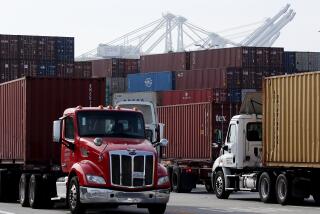In Mexico, old U.S. cars find new homes
CIUDAD JUAREZ, MEXICO â While some Americans are congratulating themselves on switching to fuel-sipping cars, their old gas guzzlers just wonât die. Lowered trade barriers are giving them new life south of the border.
Thousands of used vehicles from as far away as Colorado and Missouri jam tiny car lots and auto salvage yards in this gritty border city. An estimated 25,000 families make a living here hustling U.S. castoffs. Among them is Jose Zavala, a wiry used-car dealer with a truckerâs cap and an eye for bargains.
At a recent auto auction in neighboring El Paso, Texas, he snagged a decrepit 1974 Ford Gran Torino that brought snickers from the crowd. But itâs Zavala who may have the last laugh. He figures he can sell the wizened muscle car to some âStarsky & Hutchâ wannabe in Juarez for at least four times the $100 that he paid for it.
âIf itâs cheap and it runs,â it will find a home in Mexico, Zavala said.
Thatâs precisely what is worrying environmentalists and new-car dealers, who say falling trade barriers are fueling an invasion of smoky junkers. More than 3 million late-model vehicles have rumbled legally south of the border in the last 2 1/2 years. Millions more are on the way, thanks to the North American Free Trade Agreement.
The vintage metal is rattling Mexicoâs retail car market. Sales of new vehicles have stalled at 1.1 million a year as used imports have overtaken them. Sales of new subcompacts -- the most popular class of cars in Mexico because of their price -- skidded 16.4% last year as buyers snapped up cheaper, roomier used vehicles from the U.S.
Factory worker David Ortiz was checking out sport utility vehicles recently on Calle Carlos Amaya in Ciudad Juarez. The public street doubles as an open-air auto bazaar with hundreds of high-mileage, late-model vehicles parked bumper to dented bumper. He said used cars from the U.S. were more desirable than those from Mexico because they tend to be bigger and to have spent less time on pitted, unpaved streets such as those common in parts of Juarez.
âTheyâve got good roads over there,â he said of the United States.
For decades, Mexico restricted imports of used vehicles and slapped hefty taxes on new ones, which meant Mexicans paid more than U.S. consumers for the exact same vehicles. That spawned a huge black market in jalopies, particularly in the border region.
Things changed in summer 2005 as the Mexican government was gearing up to meet its NAFTA obligations. That trade deal requires Mexico to begin opening its market to some used vehicles from the U.S. and Canada next year. The pact is structured to protect Mexican car dealers from immediate competition against their newest, most profitable models. Only vehicles 10 years and older will be allowed in initially. Those age restrictions will gradually be reduced until 2019, when the used-car market will be completely open.
But in a move that surprised environmentalists and new-car dealers, former Mexican President Vicente Fox sped up the process in August 2005, signing a decree to allow the import of vehicles 10 to 15 years old. That decree was modified this year to allow imports of only 1998 models for the rest of 2008. NAFTA regulations will go into effect Jan. 1, 2009.
The explosion of heavy metal in the last 2 1/2 years has stunned even veteran industry observers. Imported used cars already account for 13% of Mexicoâs fleet, and that share is growing quickly. Some fear Mexico could end up like Peru, which has been swamped with low-price hand-me-downs from the U.S. and Japan since it opened its market in 1992.
âItâs a grave threatâ to new-vehicle sales, said Alfredo Llorente, director general of the Mexican Automotive Distributors Assn.
That could be bad news for the Big Three U.S. automakers, for which Mexico has been an important consumer of new vehicles.
Air quality experts are fuming as well. The used imports are supposed to meet smog and safety standards, but Mexico has yet to put a comprehensive testing system in place. Car dealer Zavala said he would get his â74 Ford across the border by paying a small bribe to Mexican customs officials.
Some environmentalists view Juarez as a prototypical âclunker capitalâ that could be replicated throughout Mexico. Most of the 600,000 cars and trucks circulating here are from the United States, and ownership is much higher than the Mexican average: one car for every two adult citizens compared with 1 for every 5 nationwide.
The fleet is much dirtier than those in other parts of the country, according to a 2006 study by the Mario Molina Center, a Mexico City-based environmental organization.
But itâs not just Mexico thatâs suffering the fallout. Autos are the main source of pollution in the Paso del Norte air basin, which includes Juarez and the U.S. cities of El Paso and Las Cruces, N.M.
âThereâs no glass window shielding the border,â said Alma Leticia Figueroa Jimenez, the former head of ecology for Ciudad Juarez. âThe U.S. sends us junk, and Mexico sends back pollution.â
But Victor Valenzuela, an air quality expert with the Texas Commission on Environmental Quality, says there is cause for optimism. Although NAFTA will allow very old used cars to be imported to Mexico, it will eventually permit newer ones to enter as well. That should lower prices and enable buyers to upgrade to cleaner vehicles, he said.
Mexico City mechanic Carlos Suarez is thrilled that NAFTA is prying open Mexicoâs retail car trade, in which he said new-car dealers have reaped outsized profits for years. Every month or two he flies to Juarez and buys an imported vehicle to sell back home. His latest acquisition: a 1998 GMC van for $3,000 that he hopes to sell for $5,000.
âWhy should they make all the money?â Suarez said of new-car dealers.
Some U.S. firms have glimpsed the future. Used-car dealers from Mexico are the fastest-growing group of buyers at Manheim auto auction in El Paso, according to marketing manager Erika Ortiz.
To better serve them, the company is considering opening a service center in Juarez where they could bid for U.S. cars online without having to cross the border. Most of the auctionâs staff is bilingual. Even auctioneers who speak only English have learned to rattle off prices in Spanish.
âWe want them to feel comfortable,â Ortiz said of Mexican buyers. âThatâs where the growth is.â
--
Times staff writer Cecilia Sanchez contributed to this report.






